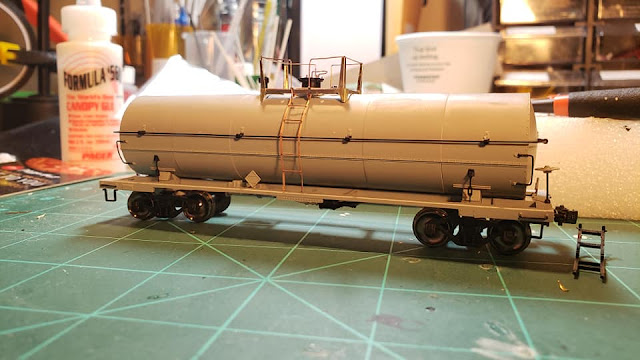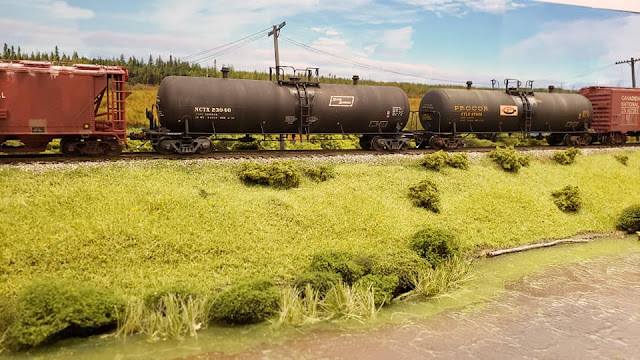Tank car rebuild
My friend Mark P. took a lot of photos during his time working in northern Manitoba. They are fertile modelling inspiration, and a couple of shots caught my eye. A couple of ACFX tank cars were photographed in Churchill at the locomotive fueling area. They were older style cars that were quite interesting in appearance. A bit of sleuthing with the scans and Google told me that they were former LPG tank cars that had been converted to general service tank cars. The high resolution scans showed that the cars had been rebuilt in the early 1970's and were still in use into the mid 1980's in my modelling area. I had to model them.
All the bits I need to do a converted LPG to general service tank car - Atlas 11K gallon tank car, Yarmouth Model Works etched platform and spare Walthers tank car parts.Both Atlas and Kadee make this style of LPG car in HO, so I picked up a couple of them to do the conversion. One has a top platform and railings and the other only has side platforms. The two prototype cars have different styles of platforms; one has a full top platform, the other only has side platforms with railings. Yarmouth Model Works makes an etched brass platform and ladder that will work for these cars.
A few spare Walthers parts from their old tank car kits gives me the other parts needed to do the model. Off we go!
I managed to find an undecorated Atlas car. I realize the Kadee cars are more accurate, however they are like finding hen's teeth these days. I did however make more work for myself than I needed to. I cut off the bottom portion of the dome (the top was a press fit and popped right off) and sanded it flush, only to realize when I looked at the photo more closely that the manway was added to the existing dome base on the prototype - whoops!
I used a piece of 1/4" diameter styrene tube with the top ring of the original dome glued on it to replace the original part. It looks reasonable.
Wathers tank car parts were glued in place to represent the vents and manway of the prototype. Their locations are approximate based on the single photo I have. I'm sure they are not exactly located but pretty close.
On the manway I decided to add some more detail to make it pop a bit more as the Walthers part is pretty basic. On the prototype there are latches that hold the manway cover in place. I drilled 0.0125" holes and glued small pieces of 0.0125" phosphor bronze wire in the holes to replicate this feature. I also added a handle as seen in the photo that was used to open the manway. This was made of 0.0125" wire and bent to shape, then glued in place. The holes for the original side platforms were filled with gap filling CA and 0.040" x 0.030" styrene. When the CA dried the area was sanded smooth.
I also added some weight to the car to bring up the overall weight. Next up with be reassembling the car and adding the walkway and ladders, as well as the unloading valve on the bottom of the car.
I test fit the platform. The Yarmouth kit has a large dome so the platform is quite wide to accommodate this. I think I'll have to narrow the platform to better fit the car. I modified the platform to narrow it to a more prototypical width. I guesstimated 5 feet across based on some other model tank car platforms. I added some 4x12 styrene strip for the platform walkways. Based on the photos it looks like the cars had solid top walkways, I'm going to assume by the 1970's they would be steel. Once I'm done someone will find a perfect photo of one of these cars showing that I'm totally out to lunch. I added etched Cannon & Co. treadplate on the walkways since they appear to have been solid plate not open tread.
To represent the platform supports I cut shim brass to shape and folded it and glued them on the corners. The dimensions for the supports was pure guesswork based on measurements of the Yarmouth platform and the height from the carbody to the platform.
The Yarmouth ladders and Atlas ladders are too short for this build so I needed to find something else. And lo and behold the ladders for my tank hopper etchings have the right rung spacing as well as the right height.

A test etching was sacrificed (the etchings needed revision so they were not useable) and I chopped out 2 ladders and removed a couple of rungs at the appropriate locations, bent them to shape and glued them in place.
I primed the car with Vallejo grey primer and once that was dry I used a custom mix of Vallejo black, dark grey and anthracite grey to get a warm black for the car. I find it helps bring the car details out.
I did make one mistake: I foolishly picked up the car before the paint had set so I smudged an area of the car. Fortunately I was wearing gloves so managed to avoid actual fingerprints, just smudged it. I tried to wet sand using 1000 grit sandpaper and it was actually going reasonably well until I peeled off some primer as well as the smudge.
Plan A didn't work, move to plan B. I trimmed back the peeled primer to a rectangular area and redid it with primer followed by (hopefully) a warm weathered black similar to the rest of the car.
There is a bit of a lip around the repaired area but hopefully that will disappear when the car is weathered. I can say that this car was patched in this area. Yeah, that's the ticket.
I had Bill Brillinger at Precision Design Company do some really nice custom decals for these cars a while back as part of a larger batch of decals I had him design and print for me. They are designed specifically for these cars. I have extra sets if anyone is interested. Drop me a line at mlwm420 <AT> gmail <DOT> com.

I airbrushed Vallejo Gloss Varnish on the car and decalled the car using my custom decals. The decals went on beautifully and I had a nice car for the layout. I used Tamiya TS-80 flat finish in a rattle can to get a nice flat finish for weathering. Another car ready for service on the Hudson Bay Railway.





















Hello to everyone .
ReplyDeleteI have a little question that concern the pointe st-charle CN steel cabooses ?
Can someone explaned to me (what is the meanning ) of the letter ( F ) on the spare coupler jaw or head that fixed on each side of the caboose ?
I'm wondering the exact reason of that letter ( F ) ????
Thank's in advance to the cn caboose expert that can explaned this ?
Send a reply to : sarachanel@videotron.ca
Dan .